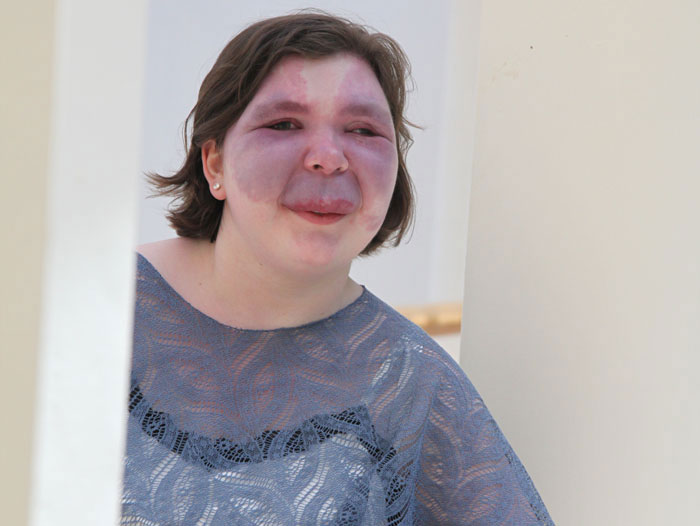Cause of Port Wine Birthmarks & Rare Disorder Found

A single genetic mutation is the cause of "port wine" birthmarks, as well as a rare neurological condition of which the birthmarks are a distinctive feature, researchers have discovered.
The mutation occurs after conception — it is not present in sperm or egg cells — but exactly when it occurs could determine whether a baby develops only a birthmark, or the serious neurological disorder Sturge-Weber syndrome, the researchers say. People with this disorder have port wine birthmarks (reddish to purplish discolorations), typically on the face, and also can suffer seizures, paralysis, blindness and learning disabilities.
Finding the genetic cause of Sturge-Weber syndrome and port wine birthmarks is the first step in developing new treatments for the conditions, the researchers said.
"One has to know what one's trying to fix," said study researcher Jonathan Pevsner, director of Bioinformatics at Kennedy Krieger Institute, an organization in Baltimore that researches child developmental disorders.
While it was suspected that the Sturge-Weber syndrome was caused by a mutation that occurs after conception, rather than an inherited mutation, this study is the first to prove that hypothesis.
It will be a relief to parents to know that they didn't pass on the condition to their child, said Karen Ball, founder and president of the Sturge-Weber Foundation, and the mother of a child with Sturge-Weber syndrome.
"[It's] is going to bring great comfort to people," Ball said.
Sign up for the Live Science daily newsletter now
Get the world’s most fascinating discoveries delivered straight to your inbox.
Understanding the cause
People with Sturge-Weber syndrome have abnormal blood vessels in the skin, brain and eyes, which cause the symptoms of the disorder. When cells of the skin are affected, the result is the port wine birthmark.
About 1 in 20,000 babies are born with Sturge-Weber syndrome, while port wine birthmarks are more common, affecting about a million people in the United States. [See What are Birthmarks?]
When Ball gave birth to her daughter with Sturge-Weber syndrome in 1986, she could find virtually no information about it. In 1987, she started the Sturge-Weber Foundation to facilitate research into the condition.
Only recently have researchers had the technology to investigate the genetic cause of Sturge-Weber syndrome.
In the new study, researchers sequenced the entire genomes of three people with Sturge-Weber syndrome, comparing the genes from normal and abnormal cells. They found a single place where the genomes differed, in a gene called GNAQ.
In a larger study, the researchers found the same mutation in 23 out of 26 with Sturge-Weber syndrome, and 12 of 13 people with port wine stains, but not in any of six healthy people they tested who did not have either condition.
The Sturge-Weber Foundation syndrome provided funding and many of the tissue samples used in the study.
New treatments
Currently, there is no cure for either Sturge-Weber syndrome or port wine stains. Treatment for Sturge-Weber syndrome includes managing the symptoms, such as medications to treat seizures, and surgeries to treat glaucoma and overgrowths of tissue.
Doctors can attempt to lighten or remove port wine stains with laser treatments, but they often reoccur.
Now that researchers know the genetic cause of the conditions, they can begin to investigate drugs that affect the cellular signaling pathways the gene is involved in. It's possible such drugs could reverse the progression of the Sturge-Weber syndrome, said Dr. Anne Comi, director of the Kennedy Krieger Institute's Hunter Nelson Sturge-Weber Center.
A mutation in the GNAQ is also involved in uveal melanoma, a type of melanoma that occurs in the eye. As a result, there has already been significant research into GNAQ and the pathways it affects.
"This is helpful to us because we can move quickly to understand the basic biology" of how the mutation leads to Sturge-Weber syndrome and port wine stains, Pevsner said.
Pass it on: The genetic cause of Sturge-Weber syndrome and port wine stains has been discovered.
Follow Rachael Rettner @RachaelRettner. Follow MyHealthNewsDaily @MyHealth_MHND, Facebook & Google+. Originally published on MyHealthNewsDaily.

Rachael is a Live Science contributor, and was a former channel editor and senior writer for Live Science between 2010 and 2022. She has a master's degree in journalism from New York University's Science, Health and Environmental Reporting Program. She also holds a B.S. in molecular biology and an M.S. in biology from the University of California, San Diego. Her work has appeared in Scienceline, The Washington Post and Scientific American.









